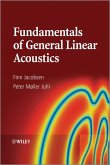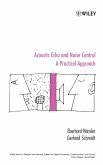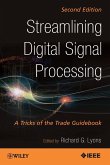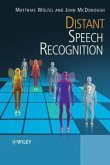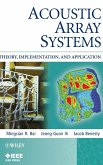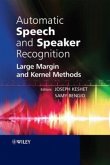- Gebundenes Buch
- Merkliste
- Auf die Merkliste
- Bewerten Bewerten
- Teilen
- Produkt teilen
- Produkterinnerung
- Produkterinnerung
In communication acoustics, the communication channel consists of a sound source, a channel (acoustic and/or electric) and finally the receiver: the human auditory system, a complex and intricate system that shapes the way sound is heard. Thus, when developing techniques in communication acoustics, such as in speech, audio and aided hearing, it is important to understand the time-frequency-space resolution of hearing. This book facilitates the reader's understanding and development of speech and audio techniques based on our knowledge of the auditory perceptual mechanisms by introducing the…mehr
Andere Kunden interessierten sich auch für
![Fundamentals of General Linear Acoustics Fundamentals of General Linear Acoustics]() Finn JacobsenFundamentals of General Linear Acoustics78,99 €
Finn JacobsenFundamentals of General Linear Acoustics78,99 €![Acoustic Echo and Noise Control Acoustic Echo and Noise Control]() Eberhard HänslerAcoustic Echo and Noise Control146,99 €
Eberhard HänslerAcoustic Echo and Noise Control146,99 €![Real-Time Digital Signal Processing Real-Time Digital Signal Processing]() Sen M. KuoReal-Time Digital Signal Processing101,99 €
Sen M. KuoReal-Time Digital Signal Processing101,99 €![Streamlining Digital Signal Processing Streamlining Digital Signal Processing]() R.G LyonsStreamlining Digital Signal Processing87,99 €
R.G LyonsStreamlining Digital Signal Processing87,99 €![Distant Speech Recognition Distant Speech Recognition]() Matthias Chr. WoelfelDistant Speech Recognition125,99 €
Matthias Chr. WoelfelDistant Speech Recognition125,99 €![Microphone Acousitc Array Sys Microphone Acousitc Array Sys]() Mingsian R. BaiMicrophone Acousitc Array Sys154,99 €
Mingsian R. BaiMicrophone Acousitc Array Sys154,99 €![Automatic Speech and Speaker Recognition Automatic Speech and Speaker Recognition]() Automatic Speech and Speaker Recognition124,99 €
Automatic Speech and Speaker Recognition124,99 €-
-
-
In communication acoustics, the communication channel consists of a sound source, a channel (acoustic and/or electric) and finally the receiver: the human auditory system, a complex and intricate system that shapes the way sound is heard. Thus, when developing techniques in communication acoustics, such as in speech, audio and aided hearing, it is important to understand the time-frequency-space resolution of hearing.
This book facilitates the reader's understanding and development of speech and audio techniques based on our knowledge of the auditory perceptual mechanisms by introducing the physical, signal-processing and psychophysical background to communication acoustics. It then provides a detailed explanation of sound technologies where a human listener is involved, including audio and speech techniques, sound quality measurement, hearing aids and audiology.
Key features:
Explains perceptually-based audio: the authors take a detailed but accessible engineering perspective on sound and hearing with a focus on the human place in the audio communications signal chain, from psychoacoustics and audiology to optimizing digital signal processing for human listening.
Presents a wide overview of speech, from the human production of speech sounds and basics of phonetics to major speech technologies, recognition and synthesis of speech and methods for speech quality evaluation.
Includes MATLAB examples that serve as an excellent basis for the reader's own investigations into communication acoustics interaction schemes which intuitively combine touch, vision and voice for lifelike interactions.
Hinweis: Dieser Artikel kann nur an eine deutsche Lieferadresse ausgeliefert werden.
This book facilitates the reader's understanding and development of speech and audio techniques based on our knowledge of the auditory perceptual mechanisms by introducing the physical, signal-processing and psychophysical background to communication acoustics. It then provides a detailed explanation of sound technologies where a human listener is involved, including audio and speech techniques, sound quality measurement, hearing aids and audiology.
Key features:
Explains perceptually-based audio: the authors take a detailed but accessible engineering perspective on sound and hearing with a focus on the human place in the audio communications signal chain, from psychoacoustics and audiology to optimizing digital signal processing for human listening.
Presents a wide overview of speech, from the human production of speech sounds and basics of phonetics to major speech technologies, recognition and synthesis of speech and methods for speech quality evaluation.
Includes MATLAB examples that serve as an excellent basis for the reader's own investigations into communication acoustics interaction schemes which intuitively combine touch, vision and voice for lifelike interactions.
Hinweis: Dieser Artikel kann nur an eine deutsche Lieferadresse ausgeliefert werden.
Produktdetails
- Produktdetails
- Verlag: Wiley & Sons
- 1. Auflage
- Seitenzahl: 456
- Erscheinungstermin: 16. Januar 2015
- Englisch
- Abmessung: 250mm x 175mm x 29mm
- Gewicht: 810g
- ISBN-13: 9781118866542
- ISBN-10: 1118866541
- Artikelnr.: 40700549
- Herstellerkennzeichnung
- Wiley John + Sons
- Southern Gate, Chichester
- P019 8SQ West Sussex, GB
- 0130 815199
- Verlag: Wiley & Sons
- 1. Auflage
- Seitenzahl: 456
- Erscheinungstermin: 16. Januar 2015
- Englisch
- Abmessung: 250mm x 175mm x 29mm
- Gewicht: 810g
- ISBN-13: 9781118866542
- ISBN-10: 1118866541
- Artikelnr.: 40700549
- Herstellerkennzeichnung
- Wiley John + Sons
- Southern Gate, Chichester
- P019 8SQ West Sussex, GB
- 0130 815199
Ville Pulkki, Department of Signal Processing and Acoustics, University of Aalto, Finland Professor Pulkki is currently affiliated to the Department of Signal Processing and Acoustics at the University of Aalto, Finland where he leads the Spatial Sound Research Group. He is an AES Fellow. Professor Pulkki was General Chair of the AES 45th International Conference on Applications of Time-Frequency Processing in Audio (2012), and he is Associate Technical Editor of the Journal of the Audio Engineering Society. Matti Karjalainen, Department of Signal Processing and Acoustics, University of Aalto, Finland Professor Karjalainen was previously Head of the Laboratory of Acoustics and Audio Signal Processing at Helsinki University of Technology which now forms part of the Department of Signal Processing and Acoustics at the University of Aalto, Finland. Professor Karjalainen had long term cooperation with companies such as Nokia and loudspeaker manufacturer Genelec. For his scientific and educational merits in audio signal processing, he received the Audio Engineering Society Fellowship in 1999, the AES Silver Medal in 2006, and the IEEE Fellowship in 2009. He published over 350 scientific and technical publications. Professor Karjalainen passed away in May 2010.
About the Authors xix Preface xxi Preface to the Unfinished Manuscript of
the Book xxiii Introduction 1 1 How to Study and Develop Communication
Acoustics 7 1.1 Domains of Knowledge 7 1.2 Methodology of Research and
Development 8 1.3 Systems Approach to Modelling 10 1.4 About the Rest of
this Book 12 1.5 Focus of the Book 12 1.6 Intended Audience 13 References
14 2 Physics of Sound 15 2.1 Vibration and Wave Behaviour of Sound 15 2.2
Acoustic Measures and Quantities 23 2.3 Wave Phenomena 26 2.4 Sound in
Closed Spaces: Acoustics of Rooms and Halls 34 Summary 41 Further Reading
41 References 41 3 Signal Processing and Signals 43 3.1 Signals 43 3.2
Fundamental Concepts of Signal Processing 46 3.3 Digital Signal Processing
(DSP) 56 3.4 Hidden Markov Models 62 3.5 Concepts of Intelligent and
Learning Systems 63 Summary 64 Further Reading 64 References 64 4
Electroacoustics and Responses of Audio Systems 67 4.1 Electroacoustics 67
4.2 Audio System Responses 71 4.3 Response Equalization 76 Summary 77
Further Reading 78 References 78 5 Human Voice 79 5.1 Speech Production 79
5.2 Units and Notation of Speech used in Phonetics 84 5.3 Modelling of
Speech Production 90 5.4 Singing Voice 96 Summary 96 Further Reading 97
References 97 6 Musical Instruments and Sound Synthesis 99 6.1 Acoustic
Instruments 99 6.2 Sound Synthesis in Music 104 Summary 108 Further Reading
108 References 108 7 Physiology and Anatomy of Hearing 111 7.1 Global
Structure of the Ear 111 7.2 External Ear 112 7.3 Middle Ear 113 7.4 Inner
Ear 115 7.5 Otoacoustic Emissions 123 7.6 Auditory Nerve 123 7.7 Auditory
Nervous System 127 7.8 Motivation for Building Computational Models of
Hearing 130 Summary 131 Further Reading 131 References 131 8 The Approach
and Methodology of Psychoacoustics 133 8.1 Sound Events versus Auditory
Events 133 8.2 Psychophysical Functions 135 8.3 Generation of Sound Events
135 8.4 Selection of Subjects for Listening Tests 138 8.5 What are We
Measuring? 138 8.6 Tasks for Subjects 141 8.7 Basic Psychoacoustic Test
Methods 142 8.8 Descriptive Sensory Analysis 145 8.9 Psychoacoustic Tests
from the Point of View of Statistics 149 Summary 149 Further Reading 150
References 150 9 Basic Function of Hearing 153 9.1 Effective Hearing Area
153 9.2 Spectral Masking 156 9.3 Temporal Masking 161 9.4 Frequency
Selectivity of Hearing 163 Summary 169 Further Reading 169 References 169
10 Basic Psychoacoustic Quantities 171 10.1 Pitch 171 10.2 Loudness 179
10.3 Timbre 188 10.4 Subjective Duration of Sound 189 Summary 191 Further
Reading 191 References 191 11 Further Analysis in Hearing 193 11.1
Sharpness 193 11.2 Detection of Modulation and Sound Onset 195 11.3
Roughness 198 11.4 Tonality 200 11.5 Discrimination of Changes in Signal
Magnitude and Phase Spectra 201 11.6 Psychoacoustic Concepts and Music 206
11.7 Perceptual Organization of Sound 212 Summary 216 Further Reading 217
References 217 12 Spatial Hearing 219 12.1 Concepts and Definitions for
Spatial Hearing 219 12.2 Head-Related Acoustics 222 12.3 Localization Cues
226 12.4 Localization Accuracy 235 12.5 Directional Hearing in Enclosed
Spaces 239 12.6 Binaural Advantages in Timbre Perception 241 12.7
Perception of Source Distance 243 Summary 246 Further Reading 246
References 246 13 Auditory Modelling 249 13.1 Simple Psychoacoustic
Modelling with DFT 250 13.2 Filter Bank Models 255 13.3 Cochlear Models 260
13.4 Modelling of Higher-Level Systemic Properties 263 13.5 Models of
Spatial Hearing 265 13.6 Matlab Examples 270 Analysis 272 Summary 274
Further Reading 274 References 274 14 Sound Reproduction 277 14.1 Need for
Sound Reproduction 277 14.2 Audio Content Production 279 14.3 Listening
Set-ups 280 14.4 Recording Techniques 284 14.5 Virtual Source Positioning
293 14.6 Binaural Techniques 298 14.7 Digital Audio Effects 302 14.8
Reverberators 303 Summary 306 Further Reading and Available Toolboxes 306
References 307 15 Time-Frequency-domain Processing and Coding of Audio 311
15.1 Basic Techniques and Concepts for Time-Frequency Processing 311 15.2
Time-Frequency Transforms 317 15.3 Time-Frequency-Domain Audio-Processing
Techniques 328 Summary 332 Further Reading 332 References 332 16 Speech
Technologies 335 16.1 Speech Coding 336 16.2 Text-to-Speech Synthesis 338
16.3 Speech Recognition 345 Summary 346 Further Reading 347 References 347
17 Sound Quality 349 17.1 Historical Background of Sound Quality 350 17.2
The Many Facets of Sound Quality 351 17.3 Systemic Framework for Sound
Quality 352 17.4 Subjective Sound Quality Measurement 353 17.5 Audio
Quality 356 17.6 Quality of Speech Communication 360 17.7 Measuring Speech
Understandability with the Modulation Transfer Function 363 17.8 Objective
Speech Quality Measurement for Telecommunication 370 17.9 Sound Quality in
Auditoria and Concert Halls 374 17.10 Noise Quality 377 17.11 Product Sound
Quality 378 Summary 380 Further Reading 380 References 380 18 Other Audio
Applications 383 18.1 Virtual Reality and Game Audio Engines 383 18.2 Sonic
Interaction Design 386 18.3 Computational Auditory Scene Analysis, CASA 387
18.4 Music Information Retrieval 387 18.5 Miscellaneous Applications 389
Summary 390 Further Reading 390 References 390 19 Technical Audiology 393
19.1 Hearing Impairments and Disabilities 393 19.2 Symptoms and
Consequences of Hearing Impairments 396 19.3 The Effect of Noise on Hearing
401 19.4 Audiometry 405 19.5 Hearing Aids 409 19.6 Implantable Hearing
Solutions 414 Summary 416 Further Reading 417 References 417 Index 419
the Book xxiii Introduction 1 1 How to Study and Develop Communication
Acoustics 7 1.1 Domains of Knowledge 7 1.2 Methodology of Research and
Development 8 1.3 Systems Approach to Modelling 10 1.4 About the Rest of
this Book 12 1.5 Focus of the Book 12 1.6 Intended Audience 13 References
14 2 Physics of Sound 15 2.1 Vibration and Wave Behaviour of Sound 15 2.2
Acoustic Measures and Quantities 23 2.3 Wave Phenomena 26 2.4 Sound in
Closed Spaces: Acoustics of Rooms and Halls 34 Summary 41 Further Reading
41 References 41 3 Signal Processing and Signals 43 3.1 Signals 43 3.2
Fundamental Concepts of Signal Processing 46 3.3 Digital Signal Processing
(DSP) 56 3.4 Hidden Markov Models 62 3.5 Concepts of Intelligent and
Learning Systems 63 Summary 64 Further Reading 64 References 64 4
Electroacoustics and Responses of Audio Systems 67 4.1 Electroacoustics 67
4.2 Audio System Responses 71 4.3 Response Equalization 76 Summary 77
Further Reading 78 References 78 5 Human Voice 79 5.1 Speech Production 79
5.2 Units and Notation of Speech used in Phonetics 84 5.3 Modelling of
Speech Production 90 5.4 Singing Voice 96 Summary 96 Further Reading 97
References 97 6 Musical Instruments and Sound Synthesis 99 6.1 Acoustic
Instruments 99 6.2 Sound Synthesis in Music 104 Summary 108 Further Reading
108 References 108 7 Physiology and Anatomy of Hearing 111 7.1 Global
Structure of the Ear 111 7.2 External Ear 112 7.3 Middle Ear 113 7.4 Inner
Ear 115 7.5 Otoacoustic Emissions 123 7.6 Auditory Nerve 123 7.7 Auditory
Nervous System 127 7.8 Motivation for Building Computational Models of
Hearing 130 Summary 131 Further Reading 131 References 131 8 The Approach
and Methodology of Psychoacoustics 133 8.1 Sound Events versus Auditory
Events 133 8.2 Psychophysical Functions 135 8.3 Generation of Sound Events
135 8.4 Selection of Subjects for Listening Tests 138 8.5 What are We
Measuring? 138 8.6 Tasks for Subjects 141 8.7 Basic Psychoacoustic Test
Methods 142 8.8 Descriptive Sensory Analysis 145 8.9 Psychoacoustic Tests
from the Point of View of Statistics 149 Summary 149 Further Reading 150
References 150 9 Basic Function of Hearing 153 9.1 Effective Hearing Area
153 9.2 Spectral Masking 156 9.3 Temporal Masking 161 9.4 Frequency
Selectivity of Hearing 163 Summary 169 Further Reading 169 References 169
10 Basic Psychoacoustic Quantities 171 10.1 Pitch 171 10.2 Loudness 179
10.3 Timbre 188 10.4 Subjective Duration of Sound 189 Summary 191 Further
Reading 191 References 191 11 Further Analysis in Hearing 193 11.1
Sharpness 193 11.2 Detection of Modulation and Sound Onset 195 11.3
Roughness 198 11.4 Tonality 200 11.5 Discrimination of Changes in Signal
Magnitude and Phase Spectra 201 11.6 Psychoacoustic Concepts and Music 206
11.7 Perceptual Organization of Sound 212 Summary 216 Further Reading 217
References 217 12 Spatial Hearing 219 12.1 Concepts and Definitions for
Spatial Hearing 219 12.2 Head-Related Acoustics 222 12.3 Localization Cues
226 12.4 Localization Accuracy 235 12.5 Directional Hearing in Enclosed
Spaces 239 12.6 Binaural Advantages in Timbre Perception 241 12.7
Perception of Source Distance 243 Summary 246 Further Reading 246
References 246 13 Auditory Modelling 249 13.1 Simple Psychoacoustic
Modelling with DFT 250 13.2 Filter Bank Models 255 13.3 Cochlear Models 260
13.4 Modelling of Higher-Level Systemic Properties 263 13.5 Models of
Spatial Hearing 265 13.6 Matlab Examples 270 Analysis 272 Summary 274
Further Reading 274 References 274 14 Sound Reproduction 277 14.1 Need for
Sound Reproduction 277 14.2 Audio Content Production 279 14.3 Listening
Set-ups 280 14.4 Recording Techniques 284 14.5 Virtual Source Positioning
293 14.6 Binaural Techniques 298 14.7 Digital Audio Effects 302 14.8
Reverberators 303 Summary 306 Further Reading and Available Toolboxes 306
References 307 15 Time-Frequency-domain Processing and Coding of Audio 311
15.1 Basic Techniques and Concepts for Time-Frequency Processing 311 15.2
Time-Frequency Transforms 317 15.3 Time-Frequency-Domain Audio-Processing
Techniques 328 Summary 332 Further Reading 332 References 332 16 Speech
Technologies 335 16.1 Speech Coding 336 16.2 Text-to-Speech Synthesis 338
16.3 Speech Recognition 345 Summary 346 Further Reading 347 References 347
17 Sound Quality 349 17.1 Historical Background of Sound Quality 350 17.2
The Many Facets of Sound Quality 351 17.3 Systemic Framework for Sound
Quality 352 17.4 Subjective Sound Quality Measurement 353 17.5 Audio
Quality 356 17.6 Quality of Speech Communication 360 17.7 Measuring Speech
Understandability with the Modulation Transfer Function 363 17.8 Objective
Speech Quality Measurement for Telecommunication 370 17.9 Sound Quality in
Auditoria and Concert Halls 374 17.10 Noise Quality 377 17.11 Product Sound
Quality 378 Summary 380 Further Reading 380 References 380 18 Other Audio
Applications 383 18.1 Virtual Reality and Game Audio Engines 383 18.2 Sonic
Interaction Design 386 18.3 Computational Auditory Scene Analysis, CASA 387
18.4 Music Information Retrieval 387 18.5 Miscellaneous Applications 389
Summary 390 Further Reading 390 References 390 19 Technical Audiology 393
19.1 Hearing Impairments and Disabilities 393 19.2 Symptoms and
Consequences of Hearing Impairments 396 19.3 The Effect of Noise on Hearing
401 19.4 Audiometry 405 19.5 Hearing Aids 409 19.6 Implantable Hearing
Solutions 414 Summary 416 Further Reading 417 References 417 Index 419
About the Authors xix Preface xxi Preface to the Unfinished Manuscript of
the Book xxiii Introduction 1 1 How to Study and Develop Communication
Acoustics 7 1.1 Domains of Knowledge 7 1.2 Methodology of Research and
Development 8 1.3 Systems Approach to Modelling 10 1.4 About the Rest of
this Book 12 1.5 Focus of the Book 12 1.6 Intended Audience 13 References
14 2 Physics of Sound 15 2.1 Vibration and Wave Behaviour of Sound 15 2.2
Acoustic Measures and Quantities 23 2.3 Wave Phenomena 26 2.4 Sound in
Closed Spaces: Acoustics of Rooms and Halls 34 Summary 41 Further Reading
41 References 41 3 Signal Processing and Signals 43 3.1 Signals 43 3.2
Fundamental Concepts of Signal Processing 46 3.3 Digital Signal Processing
(DSP) 56 3.4 Hidden Markov Models 62 3.5 Concepts of Intelligent and
Learning Systems 63 Summary 64 Further Reading 64 References 64 4
Electroacoustics and Responses of Audio Systems 67 4.1 Electroacoustics 67
4.2 Audio System Responses 71 4.3 Response Equalization 76 Summary 77
Further Reading 78 References 78 5 Human Voice 79 5.1 Speech Production 79
5.2 Units and Notation of Speech used in Phonetics 84 5.3 Modelling of
Speech Production 90 5.4 Singing Voice 96 Summary 96 Further Reading 97
References 97 6 Musical Instruments and Sound Synthesis 99 6.1 Acoustic
Instruments 99 6.2 Sound Synthesis in Music 104 Summary 108 Further Reading
108 References 108 7 Physiology and Anatomy of Hearing 111 7.1 Global
Structure of the Ear 111 7.2 External Ear 112 7.3 Middle Ear 113 7.4 Inner
Ear 115 7.5 Otoacoustic Emissions 123 7.6 Auditory Nerve 123 7.7 Auditory
Nervous System 127 7.8 Motivation for Building Computational Models of
Hearing 130 Summary 131 Further Reading 131 References 131 8 The Approach
and Methodology of Psychoacoustics 133 8.1 Sound Events versus Auditory
Events 133 8.2 Psychophysical Functions 135 8.3 Generation of Sound Events
135 8.4 Selection of Subjects for Listening Tests 138 8.5 What are We
Measuring? 138 8.6 Tasks for Subjects 141 8.7 Basic Psychoacoustic Test
Methods 142 8.8 Descriptive Sensory Analysis 145 8.9 Psychoacoustic Tests
from the Point of View of Statistics 149 Summary 149 Further Reading 150
References 150 9 Basic Function of Hearing 153 9.1 Effective Hearing Area
153 9.2 Spectral Masking 156 9.3 Temporal Masking 161 9.4 Frequency
Selectivity of Hearing 163 Summary 169 Further Reading 169 References 169
10 Basic Psychoacoustic Quantities 171 10.1 Pitch 171 10.2 Loudness 179
10.3 Timbre 188 10.4 Subjective Duration of Sound 189 Summary 191 Further
Reading 191 References 191 11 Further Analysis in Hearing 193 11.1
Sharpness 193 11.2 Detection of Modulation and Sound Onset 195 11.3
Roughness 198 11.4 Tonality 200 11.5 Discrimination of Changes in Signal
Magnitude and Phase Spectra 201 11.6 Psychoacoustic Concepts and Music 206
11.7 Perceptual Organization of Sound 212 Summary 216 Further Reading 217
References 217 12 Spatial Hearing 219 12.1 Concepts and Definitions for
Spatial Hearing 219 12.2 Head-Related Acoustics 222 12.3 Localization Cues
226 12.4 Localization Accuracy 235 12.5 Directional Hearing in Enclosed
Spaces 239 12.6 Binaural Advantages in Timbre Perception 241 12.7
Perception of Source Distance 243 Summary 246 Further Reading 246
References 246 13 Auditory Modelling 249 13.1 Simple Psychoacoustic
Modelling with DFT 250 13.2 Filter Bank Models 255 13.3 Cochlear Models 260
13.4 Modelling of Higher-Level Systemic Properties 263 13.5 Models of
Spatial Hearing 265 13.6 Matlab Examples 270 Analysis 272 Summary 274
Further Reading 274 References 274 14 Sound Reproduction 277 14.1 Need for
Sound Reproduction 277 14.2 Audio Content Production 279 14.3 Listening
Set-ups 280 14.4 Recording Techniques 284 14.5 Virtual Source Positioning
293 14.6 Binaural Techniques 298 14.7 Digital Audio Effects 302 14.8
Reverberators 303 Summary 306 Further Reading and Available Toolboxes 306
References 307 15 Time-Frequency-domain Processing and Coding of Audio 311
15.1 Basic Techniques and Concepts for Time-Frequency Processing 311 15.2
Time-Frequency Transforms 317 15.3 Time-Frequency-Domain Audio-Processing
Techniques 328 Summary 332 Further Reading 332 References 332 16 Speech
Technologies 335 16.1 Speech Coding 336 16.2 Text-to-Speech Synthesis 338
16.3 Speech Recognition 345 Summary 346 Further Reading 347 References 347
17 Sound Quality 349 17.1 Historical Background of Sound Quality 350 17.2
The Many Facets of Sound Quality 351 17.3 Systemic Framework for Sound
Quality 352 17.4 Subjective Sound Quality Measurement 353 17.5 Audio
Quality 356 17.6 Quality of Speech Communication 360 17.7 Measuring Speech
Understandability with the Modulation Transfer Function 363 17.8 Objective
Speech Quality Measurement for Telecommunication 370 17.9 Sound Quality in
Auditoria and Concert Halls 374 17.10 Noise Quality 377 17.11 Product Sound
Quality 378 Summary 380 Further Reading 380 References 380 18 Other Audio
Applications 383 18.1 Virtual Reality and Game Audio Engines 383 18.2 Sonic
Interaction Design 386 18.3 Computational Auditory Scene Analysis, CASA 387
18.4 Music Information Retrieval 387 18.5 Miscellaneous Applications 389
Summary 390 Further Reading 390 References 390 19 Technical Audiology 393
19.1 Hearing Impairments and Disabilities 393 19.2 Symptoms and
Consequences of Hearing Impairments 396 19.3 The Effect of Noise on Hearing
401 19.4 Audiometry 405 19.5 Hearing Aids 409 19.6 Implantable Hearing
Solutions 414 Summary 416 Further Reading 417 References 417 Index 419
the Book xxiii Introduction 1 1 How to Study and Develop Communication
Acoustics 7 1.1 Domains of Knowledge 7 1.2 Methodology of Research and
Development 8 1.3 Systems Approach to Modelling 10 1.4 About the Rest of
this Book 12 1.5 Focus of the Book 12 1.6 Intended Audience 13 References
14 2 Physics of Sound 15 2.1 Vibration and Wave Behaviour of Sound 15 2.2
Acoustic Measures and Quantities 23 2.3 Wave Phenomena 26 2.4 Sound in
Closed Spaces: Acoustics of Rooms and Halls 34 Summary 41 Further Reading
41 References 41 3 Signal Processing and Signals 43 3.1 Signals 43 3.2
Fundamental Concepts of Signal Processing 46 3.3 Digital Signal Processing
(DSP) 56 3.4 Hidden Markov Models 62 3.5 Concepts of Intelligent and
Learning Systems 63 Summary 64 Further Reading 64 References 64 4
Electroacoustics and Responses of Audio Systems 67 4.1 Electroacoustics 67
4.2 Audio System Responses 71 4.3 Response Equalization 76 Summary 77
Further Reading 78 References 78 5 Human Voice 79 5.1 Speech Production 79
5.2 Units and Notation of Speech used in Phonetics 84 5.3 Modelling of
Speech Production 90 5.4 Singing Voice 96 Summary 96 Further Reading 97
References 97 6 Musical Instruments and Sound Synthesis 99 6.1 Acoustic
Instruments 99 6.2 Sound Synthesis in Music 104 Summary 108 Further Reading
108 References 108 7 Physiology and Anatomy of Hearing 111 7.1 Global
Structure of the Ear 111 7.2 External Ear 112 7.3 Middle Ear 113 7.4 Inner
Ear 115 7.5 Otoacoustic Emissions 123 7.6 Auditory Nerve 123 7.7 Auditory
Nervous System 127 7.8 Motivation for Building Computational Models of
Hearing 130 Summary 131 Further Reading 131 References 131 8 The Approach
and Methodology of Psychoacoustics 133 8.1 Sound Events versus Auditory
Events 133 8.2 Psychophysical Functions 135 8.3 Generation of Sound Events
135 8.4 Selection of Subjects for Listening Tests 138 8.5 What are We
Measuring? 138 8.6 Tasks for Subjects 141 8.7 Basic Psychoacoustic Test
Methods 142 8.8 Descriptive Sensory Analysis 145 8.9 Psychoacoustic Tests
from the Point of View of Statistics 149 Summary 149 Further Reading 150
References 150 9 Basic Function of Hearing 153 9.1 Effective Hearing Area
153 9.2 Spectral Masking 156 9.3 Temporal Masking 161 9.4 Frequency
Selectivity of Hearing 163 Summary 169 Further Reading 169 References 169
10 Basic Psychoacoustic Quantities 171 10.1 Pitch 171 10.2 Loudness 179
10.3 Timbre 188 10.4 Subjective Duration of Sound 189 Summary 191 Further
Reading 191 References 191 11 Further Analysis in Hearing 193 11.1
Sharpness 193 11.2 Detection of Modulation and Sound Onset 195 11.3
Roughness 198 11.4 Tonality 200 11.5 Discrimination of Changes in Signal
Magnitude and Phase Spectra 201 11.6 Psychoacoustic Concepts and Music 206
11.7 Perceptual Organization of Sound 212 Summary 216 Further Reading 217
References 217 12 Spatial Hearing 219 12.1 Concepts and Definitions for
Spatial Hearing 219 12.2 Head-Related Acoustics 222 12.3 Localization Cues
226 12.4 Localization Accuracy 235 12.5 Directional Hearing in Enclosed
Spaces 239 12.6 Binaural Advantages in Timbre Perception 241 12.7
Perception of Source Distance 243 Summary 246 Further Reading 246
References 246 13 Auditory Modelling 249 13.1 Simple Psychoacoustic
Modelling with DFT 250 13.2 Filter Bank Models 255 13.3 Cochlear Models 260
13.4 Modelling of Higher-Level Systemic Properties 263 13.5 Models of
Spatial Hearing 265 13.6 Matlab Examples 270 Analysis 272 Summary 274
Further Reading 274 References 274 14 Sound Reproduction 277 14.1 Need for
Sound Reproduction 277 14.2 Audio Content Production 279 14.3 Listening
Set-ups 280 14.4 Recording Techniques 284 14.5 Virtual Source Positioning
293 14.6 Binaural Techniques 298 14.7 Digital Audio Effects 302 14.8
Reverberators 303 Summary 306 Further Reading and Available Toolboxes 306
References 307 15 Time-Frequency-domain Processing and Coding of Audio 311
15.1 Basic Techniques and Concepts for Time-Frequency Processing 311 15.2
Time-Frequency Transforms 317 15.3 Time-Frequency-Domain Audio-Processing
Techniques 328 Summary 332 Further Reading 332 References 332 16 Speech
Technologies 335 16.1 Speech Coding 336 16.2 Text-to-Speech Synthesis 338
16.3 Speech Recognition 345 Summary 346 Further Reading 347 References 347
17 Sound Quality 349 17.1 Historical Background of Sound Quality 350 17.2
The Many Facets of Sound Quality 351 17.3 Systemic Framework for Sound
Quality 352 17.4 Subjective Sound Quality Measurement 353 17.5 Audio
Quality 356 17.6 Quality of Speech Communication 360 17.7 Measuring Speech
Understandability with the Modulation Transfer Function 363 17.8 Objective
Speech Quality Measurement for Telecommunication 370 17.9 Sound Quality in
Auditoria and Concert Halls 374 17.10 Noise Quality 377 17.11 Product Sound
Quality 378 Summary 380 Further Reading 380 References 380 18 Other Audio
Applications 383 18.1 Virtual Reality and Game Audio Engines 383 18.2 Sonic
Interaction Design 386 18.3 Computational Auditory Scene Analysis, CASA 387
18.4 Music Information Retrieval 387 18.5 Miscellaneous Applications 389
Summary 390 Further Reading 390 References 390 19 Technical Audiology 393
19.1 Hearing Impairments and Disabilities 393 19.2 Symptoms and
Consequences of Hearing Impairments 396 19.3 The Effect of Noise on Hearing
401 19.4 Audiometry 405 19.5 Hearing Aids 409 19.6 Implantable Hearing
Solutions 414 Summary 416 Further Reading 417 References 417 Index 419


